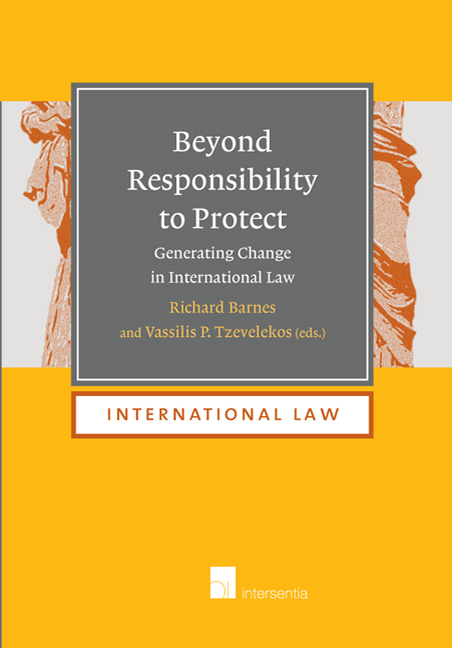Book contents
- Frontmatter
- Dedication
- Foreword
- Acknowledgements
- Contents
- Table of Cases
- List of Authors
- Introduction
- Part I The Moral Underpinnings and Political Ends of R2p
- Part II International Institutions And Their Role In R2p
- PART III De Facto Regimes and Non-State Actors Within a State And as a State
- Part IV R2p and Due Dilligence Regarding the Conduct of Corporations
- Part V The Interaction Between R2p And Humanitarian Law Obligations To Protect Civilian Populations
- PART VI R2p and International Criminal Law Beyond the Four R2p Crimes
- The Place of Aggression in the Responsibility to Protect Doctrine
- The Impact of the Responsibility to Protect on the Protection of Peacekeeping Missions under the Rome Statute of the International Criminal Court
- Commentary: R2P and its Consequences for International Criminal Law: Crimes as a Justification for the Use of Force
- Part VII R2p and its Possible Impact on the Law of International Responsibility
- Part VIII Concluding Observations
- Index
Commentary: R2P and its Consequences for International Criminal Law: Crimes as a Justification for the Use of Force
from PART VI - R2p and International Criminal Law Beyond the Four R2p Crimes
Published online by Cambridge University Press: 19 September 2018
- Frontmatter
- Dedication
- Foreword
- Acknowledgements
- Contents
- Table of Cases
- List of Authors
- Introduction
- Part I The Moral Underpinnings and Political Ends of R2p
- Part II International Institutions And Their Role In R2p
- PART III De Facto Regimes and Non-State Actors Within a State And as a State
- Part IV R2p and Due Dilligence Regarding the Conduct of Corporations
- Part V The Interaction Between R2p And Humanitarian Law Obligations To Protect Civilian Populations
- PART VI R2p and International Criminal Law Beyond the Four R2p Crimes
- The Place of Aggression in the Responsibility to Protect Doctrine
- The Impact of the Responsibility to Protect on the Protection of Peacekeeping Missions under the Rome Statute of the International Criminal Court
- Commentary: R2P and its Consequences for International Criminal Law: Crimes as a Justification for the Use of Force
- Part VII R2p and its Possible Impact on the Law of International Responsibility
- Part VIII Concluding Observations
- Index
Summary
The concept of a responsibility to protect (R2P) in international law is said to involve three distinct dimensions: (a) the responsibility to prevent (i.e. to address the root causes of a crisis); (b) the responsibility to react (i.e. to respond – either non-forcibly or, in extreme circumstances, forcibly – to a humanitarian crisis); and (c) the responsibility to rebuild (i.e. to promote recovery and reconciliation following a humanitarian crisis). By far the most controversial aspect relates to action taken within the context of R2P involving the use of armed force – in other words, actions that tended to be discussed previously under the (somewhat problematic) banner of humanitarian intervention. Although it might be argued that the scope of R2P is considerably broader, the proposition that discussion of R2P rather than humanitarian intervention reflects a linguistic trick, rather than a substantive change in relation to (at least the second arm of) the concept and its aims, can be illustrated by the approach of the International Commission on Intervention and State Sovereignty (ICISS) in its development: R2P was to be relevant to ‘civil wars, insurgencies, state repression and state collapse’, but required ‘a new approach to intervention’, informed and framed by the language used. In particular, the ICISS explained that:
‘the expression “humanitarian intervention” did not help to carry the debate forward, [… whilst …] the language of past debates arguing for or against a “right to intervene” by one state on the territory of another state is outdated and unhelpful. We prefer to talk not of a “right to intervene” but of a “responsibility to protect”’.
Both of these important contributions examine R2P in the controversial context of the use of force and military activity. First, Vito Todeschini considers the possibility of expanding the scope of R2P to include the crime of aggression. Given that the stated objective of the doctrine is to protect civilian populations from genocide, war crimes, crimes against humanity and ethnic cleansing, it might indeed seem incongruous that there is no mention of what could be considered to be the other most serious international crime.
- Type
- Chapter
- Information
- Beyond Responsibility to ProtectGenerating Change in International Law, pp. 341 - 348Publisher: IntersentiaPrint publication year: 2016



